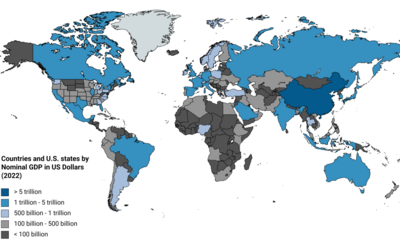California's economy is the largest of any state in the US, and is the eighth largest economy in the world. As of 2008, the gross state product (GSP) is about $1.85 trillion, which is 13% of the United States gross domestic product (GDP). The state's GDP growth rate slowed to 0.4% in 2008 after having grown 3.1% in 2006 and 1.8% in 2007. As of 2010 California along with Texas leads all other states in the number of Fortune 500 headquarters at 57 companies each.
Sectors
In 2002, the U.S. government adopted the North American Industry Classification System (NAICS) system of classifying economic activities, to better reflect today's economy.
International trade and tourism
California has historically derived significant revenue from international trade and tourism. However, the state's share of America's merchandise export trade has been steadily shrinking since 2000, from 15.4% to 11.1% in 2008.The exports of goods made in California totaled $134 billion in 2007. $48 billion of that total was computers and electronics, followed by transportation, non-electrical machinery, agriculture, and chemicals. California trade and exports translate into high-paying jobs for over one million Californians. According to the US Bureau of Economic Analysis (BEA), in 2005, foreign-controlled companies employed 542,600 California workers, the most of any state. Major sources of foreign investment in California in 2005 were Japan, the United Kingdom, Switzerland, France, and Germany. Foreign investment in California was responsible for 4.2 percent of the state's total private-industry employment in 2005. Total direct travel spending in California reached $96.7 billion in 2008, a 0.8% increase over the preceding year. Los Angeles County receives the most tourism in the state.
Agriculture (including fruit, vegetables, dairy, and wine production) is a major California industry. In fact, California is the world's fifth largest supplier of food and agriculture commodities. Agriculture accounts for just slightly over 2% of California's $1.85 trillion gross state product. Airborne exports of perishable fruits and vegetables amounted to approximately $685 million in 2007. By way of comparison, California exported more agricultural products by air that year than 23 other states did by all modes of transport.
According to the California Department of Food and Agriculture, "California agriculture is nearly a $36.6 billion dollar industry that generates $100 billion in related economic activity." The state’s agricultural sales first exceeded $30 billion in 2004,[13] making it more than twice the size of any other state's agriculture industry.
California is the leading dairy state.[14] Milk is California's number one farm commodity.[13] California's dairy industry generated $47 billion "in economic activity" in 2004 and employed over 400,000 people."
Oil and electricity
Oil drilling has played a significant role in the development of the state. There have been major strikes in the Bakersfield, Long Beach, Los Angeles areas and off the California coast.
Personal income
Per capita income was $38,956 as of 2006, ranking 11th in the nation, but varies widely by geographic region and profession. Some coastal cities include some of the wealthiest per-capita areas in the U.S., notably La Jolla in San Diego, Beverly Hills, in Los Angeles County, Newport Beach in Orange County in Southern California, San Francisco and Marin County. The most expensive and largest housing markets in the U.S. are in the state of California, so there are a number of communities where average housing prices hover between US$1–2 million. Generally, the Central Valley in northern California is the least expensive area, as is the Inland Empire in Southern California, though prices in the Inland Empire, though falling, are still much higher than the Central Valley, to the point that there are also communities in this area where housing prices average around the $1 million mark. The agricultural central counties have some of the highest poverty rates in the U.S. The high-technology sectors in Northern California, specifically Silicon Valley, in Santa Clara and San Mateo counties, are currently emerging from the economic downturn caused by the dot-com bust, which caused the loss of over 250,000 jobs in Northern California alone. As of spring 2005, data from UCLA Anderson indicates that economic growth has resumed in California, although still slightly below the national annualized forecast of 3.9%.
Tax burden
In 2006 California's overall state-level tax burden of $10.66 per $100 of personal income was slightly above the $10.43 average for the United States. In 2008, when measured as a percentage of GDP, California had the 6th highest tax burden of the fifty states and has contributed on average well over 3.65 billion dollars per year for the last twenty years into the federal treasury than it has received in Federal services in return.
Housing
The international boom in housing prices has been most pronounced in California, with the median property price in the state rising to about the half-million dollar mark in April 2005. Orange County, Ventura County and the San Francisco Bay Area have the highest median prices, each approaching $650,000. The least expensive region is the Central Valley, with a median price of $290,000.
Various real estate markets in California experienced sharp increases in value in the early 2000s, followed by declines in 2007 and 2008, as a housing bubble burst.
However, beginning in 2007 with the Credit Crunch in the banking system, thousands of homes have been foreclosed statewide, thereby leading to plummeting home prices.
See also
(source:wikipedia)



No comments:
Post a Comment